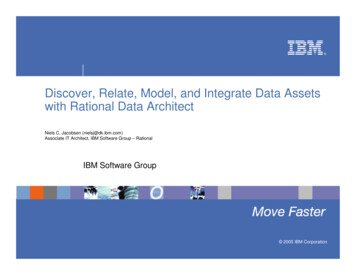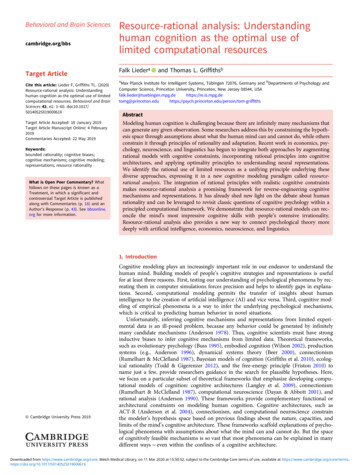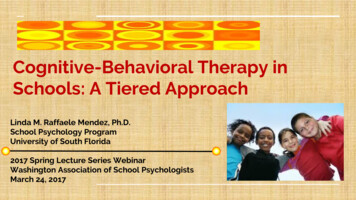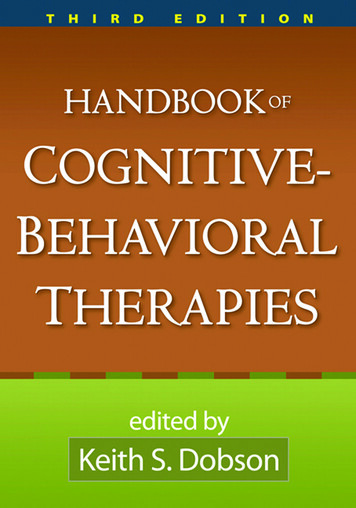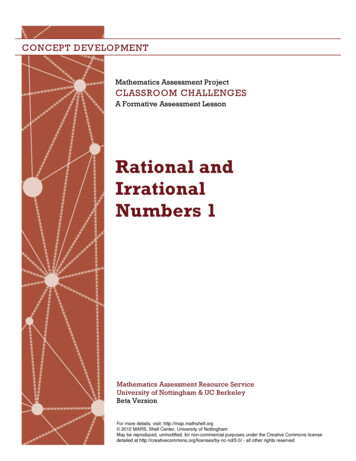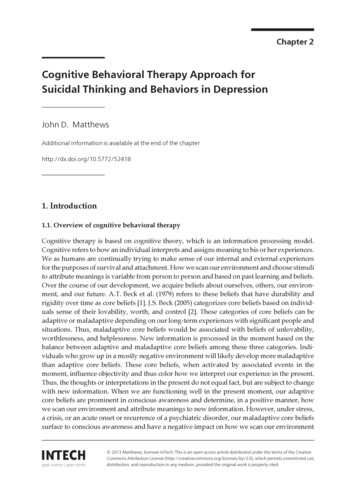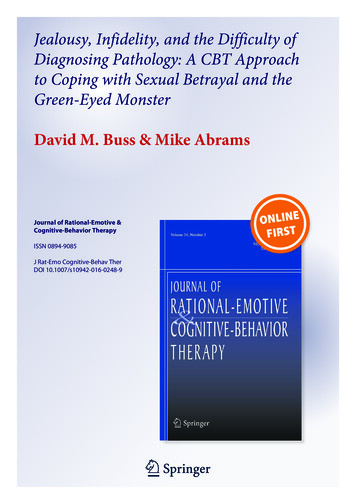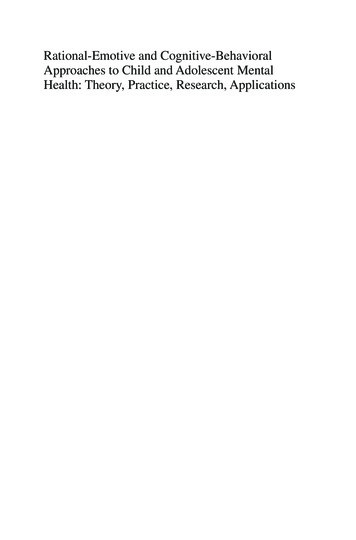
Transcription
Rational-Emotive and Cognitive-BehavioralApproaches to Child and Adolescent MentalHealth: Theory, Practice, Research, Applications
Michael Bernard Mark D. TerjesenEditorsRational-Emotiveand Cognitive-BehavioralApproaches to Child andAdolescent Mental Health:Theory, Practice, Research,Applications
EditorsMichael BernardMelbourne Graduate School of EducationUniversity of MelbourneMelbourne, VIC, AustraliaMark D. TerjesenDepartment of PsychologySt. John’s UniversityJamaica, NY, USAISBN 978-3-030-53900-9 ISBN 978-3-030-53901-6 (eBook)https://doi.org/10.1007/978-3-030-53901-6 Springer Nature Switzerland AG 2020, Corrected Publication 2021This work is subject to copyright. All rights are reserved by the Publisher, whether the whole or part ofthe material is concerned, specifically the rights of translation, reprinting, reuse of illustrations, recitation,broadcasting, reproduction on microfilms or in any other physical way, and transmission or informationstorage and retrieval, electronic adaptation, computer software, or by similar or dissimilar methodologynow known or hereafter developed.The use of general descriptive names, registered names, trademarks, service marks, etc. in this publicationdoes not imply, even in the absence of a specific statement, that such names are exempt from the relevantprotective laws and regulations and therefore free for general use.The publisher, the authors, and the editors are safe to assume that the advice and information in this bookare believed to be true and accurate at the date of publication. Neither the publisher nor the authors or theeditors give a warranty, expressed or implied, with respect to the material contained herein or for anyerrors or omissions that may have been made. The publisher remains neutral with regard to jurisdictionalclaims in published maps and institutional affiliations.This Springer imprint is published by the registered company Springer Nature Switzerland AGThe registered company address is: Gewerbestrasse 11, 6330 Cham, Switzerland
PrefaceThis book for professionals documents the evolution of Rational Emotive BehaviorTherapy (REBT) practice with younger populations. It is the third in a series ofbooks published by Springer commencing with the 1983 book I (Michael) editedwith Albert Ellis and which we completely revised in 2006. Over 12 months ago,Mark put a call into me and said it was time for the next edition. Largely through hisefforts, we assembled an amazing array of REBT-trained practitioners to write ontheir specialized applications of REBT in their field of endeavor. Only five of the2006 group of contributors (Bernard, Doyle, Esposito, Terjesen, Vernon) have madecontributions to this book with the remaining 36 authors/co-authors being new tothe book. Many of our authors represent the current generation of young mentalhealth practitioners all of whom share with us the passion for REBT. As REBT is anexample of and is the earliest form of Cognitive Behavioral Therapy (CBT), thisvolume highlights the place of REBT within the broader clinical context of CBT,offering important discussions as to the overlap as well as unique applications of thepractical and scholarly work of both REBT and CBT.When I (Michael) began my professional career in 1979 employing REBT withchildren as young as five—with their families and teachers—there was a suspicionand distrust that REBT’s verbal and cognitive form of therapy was not suitable foryounger populations. Since then, REBT has become recognized as one of two(along with Beck’s cognitive therapy) major schools of cognitive behavior therapy,and today, as illustrated throughout this book, cognitive restructuring using a varietyof creative and experiential as well as traditional strategies can be readily employedwith younger populations. Furthermore, the importance of strengthening childrenand adolescents’ capacity for rational thought and teaching explicit rational beliefs(e.g., self-acceptance) is seen as more important to today’s wholistic education ofyoung people than it was in previous generations.The type of social-emotional learning and psycho-education we employ withchildren and adolescents is partly based on a very intelligent and successful curriculum written by Bill Knaus, the psychologist of the Living School, that was situatedat the Institute for Rational Living in NYC. Bill wrote Rational Emotive Education:A Manual for Elementary School Teachers. Additionally, in 1980, Ann Vernon wrotev
viPrefacea beautiful little yellow-covered book, Help Yourself to a Happier You, that presented a wide variety of creative and experiential activities for teaching young people the ABCs of REBT. Ann’s pioneering work is very well represented in Chap. 4of this edition, “Teaching REBT to Children and Adolescents: Creative Techniquesthat Work.” Another influential text that presented the strategies for using REBTwith younger populations was the book I (Michael) wrote with Marie Joyce,Rational Emotive Therapy with Children and Adolescents: Theory, Practice,Research (John Wiley). I (Michael) was honored to have been asked by Janet Wolfe,who was at the time Executive Director of the Institute for Rational EmotiveTherapy, to write The REBT Therapist’s Pocket Companion for Working withChildren and Adolescents. Over the years, the Institute’s Director of ProfessionalTraining, Ray DiGiuseppe, added his creativity and ingenuity in demonstrating howto use REBT with younger populations.We’ve organized this book into three parts. Part I, Foundations, covers the essentials of REBT and CBT theory and practice with younger populations. Part II,Childhood Disorders, Difficulties and Different Populations, contains chaptersrevealing the depth and breadth of REBT and the broader approach of CBT’s usesto address mental health problems of childhood including integration with best- practices from allied fields. Part III, Applications, showcases how REBT and itseducational derivative Rational Emotive Education has been used as preventativemental health education in coaching of children and adolescents, and how parentsand teachers can use the ABCs and rational beliefs to manage stress and do theirpersonal best. Finally, the last chapter addresses how latest advances in technologycan help REBT and CBT ideas to be communicated to young people with challenges.It is exciting to see how REBT practice and science with younger populationshas evolved and flourished over the years from what it was in the late 1970s. Thedistinctiveness of REBT from allied CBT approaches still holds and it is a testimonyto the brilliance of Al Ellis that it has stood the test of time and proven its clinicalutility for helping young people and their significant others cope and live with mental health challenges.Melbourne, VIC, Australia Michael BernardJamaica, NY, USA Mark D. Terjesen
ContentsPart I Foundations1 Rational Emotive, Cognitive Behavioral Approachesto the Challenge of Child and Adolescent Mental Health 3Michael Bernard and Mark D. Terjesen2 The Current Status of Rational Emotive and CognitiveBehavioral Therapy (RE-CBT) Research with Childrenand Adolescents 31Mark D. Terjesen, Courtney Duhning, Alexa K. Pata,and Jessica K. Prizer3 A Compendium of REBT Principles and Best Practicesfor Working with Children and Adolescents 51Michael Bernard4 Teaching REBT to Children and Adolescents: CreativeTechniques that Work 79Ann Vernon5 Rational Emotive and Cognitive Behavioral Group Therapywith Children and Adolescents 101Mark D. Terjesen, Maria Esposito-Pickering,and Adrienne Matta6 Rational Emotive and Cognitive Behavioral Therapyin Working with Parents 125Robyn Kurasaki and Mark D. Terjesen7 The Rational Emotive Behavior Therapy Approachto Working with Families 143Olga Gulyayeva Fuller, Brooke Edelman,and Tamara Del Vecchiovii
viiiContentsPart II Childhood Disorders, Difficulties and Different Populations8 RE-CBT in the Treatment of Anxiety, Fears, and PhobiasAmong Youth 161Michael Hickey and Stephanie Schwartz9 REBT-CBT in the Treatment of Trauma Among Childrenand Adolescents 183Jaco Rossouw10 Depression in Children and Adolescents: RE-CBT Approachesto Assessment and Treatment 201Ann Vernon11 Self-Acceptance: REBT as the Psychological Armor thatProtects Children and Adolescents 223Michael Bernard12 A Rational Emotive, Cognitive Behavioral Approach inClinical Work with Suicidal and Non-suicidal Self-InjuriousBehaviors Among Children and Adolescents 241Nora Gerardi and Ennio Ammendola13 Cognitive-Behavioral, Rational-Emotive Treatment ofChildhood Anger and Conduct Problems 267John E. Lochman, Caroline L. Boxmeyer, Shannon Jones,Francesca Kassing, Nicole P. Powell, and Sara Stromeyer14 Rational-Emotive and Cognitive- Behavioral Treatment forAttention- Deficit/Hyperactivity Disorder Among Youth 285Kristene A. Doyle and Mark D. Terjesen15 RE-CBT in the Treatment of Autism Spectrum Disorder 311Korrie Allen and Veronica Milito16 Treatment of Sleep Disorders in Children and Adolescents:A Rational- Emotive, Cognitive-Behavioral Approach 331Robin J. Sakakini, Mark D. Terjesen, and Mayra Reyes-Ruiz17 Using RE-CBT with Transgender and Gender-ExpansiveChildren and Youth 351Jamie M. Joseph, Samantha Busa, and Breanne Taylor18 Rational Emotive, Cognitive Behavioral Therapy with SexualMinority Youth 371Angelica Terepka and Leonell Torres-Pagán19 Academic Procrastination and Educational Underachievement:How REBT Works 395Michael Bernard
ContentsixPart III Applications20 Rational Emotive Education as Social–Emotional Learning 419Ann Vernon and Michael Bernard21 REBT Coaching for Young People to Achieve Goalsand Develop in Life 453Demetris Katsikis and Chrysoula Kostogiannis22 Rational Emotive Parent Education 475Oana Alexandra David23 Teacher Stress Management Using Rational Emotive BehaviorTherapy 493Oksana Huk and Camille Bernstein24 Applications of Rational-Emotive and Cognitive-BehaviorTechnologies with Children and Adolescents 513Daniel O. David, Silviu A. Matu, and Roxana A. I. CardosCorrection to: Applications of Rational-Emotiveand Cognitive-Behavior Technologies with Children and Adolescent C1 Index 531
ContributorsKorrie Allen Department of Child, Family and School Psychology, University ofDenver, Denver, CO, USAEnnio Ammendola Fordham University, New York, NY, USAMichael Bernard Melbourne Graduate School of Education, University ofMelbourne, Parkville, VIC, AustraliaCamille Bernstein Psychology Department, The Hagedorn Little Village School,New Rochelle, NY, USACaroline L. Boxmeyer Academic Affairs in the College of Community HealthSciences at The University of Alabama, Tuscaloosa, AL, USADepartment of Psychiatry and Behavioral Medicine, Tuscaloosa, AL, USASamantha Busa Department of Child and Adolescent Psychiatry, HassenfeldChildren’s Hospital at NYU Langone, New York, NY, USARoxana A. I. Cardos Department of Clinical Psychology and Psychotherapy/TheInternational Institute for the Advanced Studies of Psychotherapy and AppliedMental Health, Babeș-Bolyai University, Cluj-Napoca, RomaniaDaniel O. David Department of Clinical Psychology and Psychotherapy/TheInternational Institute for the Advanced Studies of Psychotherapy and AppliedMental Health, Babeş-Bolyai University, Cluj-Napoca, RomaniaDepartment of Oncological Sciences, Icahn School of Medicine at Mount Sinai,New York, NY, USAOana Alexandra David Department of Clinical Psychology and Psychotherapy,Babes-Bolyai University, Cluj-Napoca, RomaniaTamara Del Vecchio Department of Psychology, St. John’s University, Queens,NY, USAKristene A. Doyle Albert Ellis Institute, New York, NY, USAxi
xiiContributorsCourtney Duhning St. John’s University, Jamaica, NY, USABrooke Edelman St. John’s University, Queens, NY, USAMaria Esposito-Pickering Private Practice, Amityville, NY, USAOlga Gulyayeva Fuller St. John’s University, Queens, NY, USANora Gerardi Psychologist at Cognitive & Behavioral Consultants, New York,NY, USAQueens College, New York, NY, USAMichael Hickey Center for Psychological Evaluation and the Center for Treatmentand Research of Obsessive-Compulsive & Related Disorders, Albert Ellis Institute,New York, NY, USAOksana Huk Psychology Department, Iona College, New Rochelle, NY, USAShannon (Shane) Jones Center for Youth Development and Intervention,University of Alabama, Tuscaloosa, AL, USAJamie M. Joseph Cognitive Behavior Therapy & Evaluation, Coral Springs, FL,USAFrancesca Kassing Trauma and Grief Center at Baylor College of Medicine/TexasChildren’s Hospital, Houston, TX, USADemetris Katsikis Institute for Rational-Emotive and Cognitive Behavior Therapy,Athens, GreeceChrysoula Kostogiannis Institute for Rational-Emotive and Cognitive BehaviorTherapy, Athens, GreeceRobyn Kurasaki New Hyde Park School District, New Hyde Park, NY, USAJohn E. Lochman Center for Prevention of Youth Behavior Problems at TheUniversity of Alabama, Tuscaloosa, AL, USAAdrienne Matta School Psychologist, Wilton Public Schools, Wilton, CT, USAVeronica Milito Department of School Psychology, St. Johns University, Queens,NY, USAAlexa K. Pata St. John’s University, Jamaica, New York, USANicole P. Powell Center for Youth Development and Intervention at the Universityof Alabama, Tuscaloosa, AL, USAJessica K. Prizer School Psychology, St. John’s University, Jamaica, NY, USAMayra Reyes-Ruiz St. John’s University, Queens, NY, USAJaco Rossouw Centre for Cognitive-Behaviour Therapy, Cape Town, South AfricaDepartment of Psychiatry, Faculty of Medicine and Health Science, StellenboschUniversity, Stellenbosch, South Africa
ContributorsxiiiRobin J. Sakakini School and Clinical Psychologist, Oaks Christian School, WestLake Village, CA, USAStephanie Schwartz Anxiety Disorders Center, Child Mind Institute, New York,NY, USASilviu A. Matu Department of Clinical Psychology and Psychotherapy/TheInternational Institute for the Advanced Studies of Psychotherapy and AppliedMental Health, Babeş-Bolyai University, Cluj-Napoca, RomaniaSara Stromeyer Department of Psychology, University of Alabama, Tuscaloosa,AL, USABreanne Taylor Nova Southeastern University, Fort Lauderdale, FL, USAAngelica Terepka Columbia University Irving Medical Center, New York, NY,USAMark D. Terjesen Department of Psychology, St. John’s University, Jamaica, NY,USALeonell Torres-Pagán New York Presbyterian Hospital, Columbia UniversityMedical Center, Queens, NY, USAAnn Vernon University of Northern Iowa, Tucson, AZ, USA
About the EditorsMichael Bernard, PhD, is an international consultant to universities, organizations, educational authorities, and governments. Since 2004, he has been aProfessorial Fellow at the University of Melbourne, Melbourne Graduate Schoolof Education, and an Emeritus Professor, California State University, Long Beach.He is the Founder of You Can Do It! Education (youcandoiteducation.com.au), aprogram for promoting student social-emotional well-being and achievement thatis being used in over 6000 schools in Australia, New Zealand, Vietnam, Singapore,England, Romania, and North America. Michael was the first Sport Psychologistof the Collingwood Football Team. He is the author of over 50 books, 30 bookchapters, and 30 journal articles in areas associated with student well-being andachievement, peak performance, resilience, and positive parenting. With his business partner and wife, Patricia Bernard, he has created an online positive parenting program consisting of eLearning programs, articles, and audio-videomotivational programs for young people (youcandoiteducation.com.au/parents).Michael has worked as a consultant school psychologist helping families andschools address the educational and mental health needs of school-age children.Over the past decade, he has focused on the design and conduct of high performance mindset and resilience professional development programs. Michaelhelped establish the Master of Educational Psychology program in the thenFaculty of Education, University of Melbourne. A close colleague of Albert Ellis,Fellow of the Albert Ellis Institute, an approved supervisor, and Editor for 8 yearsof the Journal of Rational-Emotive & Cognitive-Behavior Therapy, Michael isCo-founder of the Australian Institute for Rational Emotive Behaviour Therapyand is the author of many books on REBT.Mark D. Terjesen, PhD, is Professor of Psychology and Assistant Chairpersonin the Department of Psychology at St. John’s University in Queens, NY, USA. Dr.Terjesen has served as Program Director of the School Psychology (PsyD and MS)programs and has trained and supervised doctoral students throughout his tenure,having mentored over 100 doctoral dissertation research projects. Dr. Terjesenhas studied, published, and presented at a number of national and internationalxv
xviAbout the Editorsconferences on topics related to assessment and clinical work with children, adolescents, and families. He has trained many professionals internationally in the useof Rational Emotive Behavior Therapy (REBT) and cognitive-behavioral practices with children and families. Dr. Terjesen has served as President of the SchoolDivision of the New York State Psychological Association, President of theTrainers of School Psychologists, and is Past President of Division 52 (InternationalPsychology) of the American Psychological Association of which he is also a fellow. Dr. Terjesen is a Fellow of the Albert Ellis Institute and an approved supervisor. He serves as the Clinical Director at North Coast Psychological Services inSyosset, NY. Dr. Terjesen and his wife, Dr. Carolyn Waldecker, are the proud parents of Amelia Grace who has taught them how to apply the principles of REBT intheir role as parents.
Mental Health, Babeş-Bolyai University, Cluj-Napoca, Romania . Brooke Edelman St. John's University, Queens, NY, USA Maria Esposito-Pickering Private Practice . Psychologist at Cognitive & Behavioral Consultants, New York, NY, USA Queens College, New York, NY, USA Michael Hickey Center for Psychological Evaluation and the Center for .
